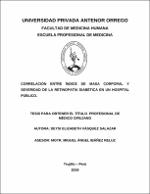Correlación entre índice de masa corporal y severidad de la retinopatía diabética en un hospital público

View/
Download
(application/pdf: 459.6Kb)
(application/pdf: 459.6Kb)
Date
2019Author(s)
Vásquez Salazar, Deysi Elizabeth
Metadata
Show full item recordAbstract
Objetivo: Establecer la existencia de correlación entre el índice de masa corporal y la severidad de la retinopatía diabética en el Hospital Belén de Trujillo. Material y Métodos: Se desarrolló un estudio observacional, analítico, seccional, transversal de correlación en 100 pacientes con diagnóstico de retinopatía diabética atendidos durante el periodo 2018 – 2019. Se obtuvo el coeficiente de correlación de Pearson entre las categorías de índice de masa corporal y de severidad de retinopatía diabética. Resultados: El promedio de edad fue de 58,89 años, con predominio del sexo femenino (63 %) y tiempo de enfermedad de 11,43 años. El promedio de peso fue de 66,42 Kg, la talla promedio de 1,56 m y el índice cintura – cadera estuvo aumentada en un 79 %. Hubo sobrepeso en un 43 %, con frecuencias para desnutrición, eutrofia y obesidad de 1 %, 30 % y 26 %, respectivamente. La glicemia en ayunas promedio fue 167,19 mg/dL, el porcentaje promedio de hemoglobina glicosilada 7,754 %, el promedio de hemoglobina de 11,476 g/dL y el índice neutrófilo / linfocito < 2,5 se presentó en un 62 %. El 42 % de niveles de hemoglobina fueron normales, con anemia leve en 40 %, anemia moderada en 17 % y anemia severa en un 1%. Se evidenció neuropatía diabética en un 68 % y nefropatía diabética de E1 en 30 %, E2 en 34 %, E3 en 15 %, E4 en 8 % y E5 en un 13 %. La agudeza visual fue: ≥ 6/18 el 42 %, < 6/18 – 6/60 el 43 %, < 6/60 – 3/60 el 10 % y < 3/60 el 5 %. La RDNP Leve constituyó un 58 % seguido de RDNP Moderada, RDNP Severa y la RDP en un 15 %, 11 % y 16 % respectivamente. Se halló correlación entre la categoría de índice de masa corporal y el grado de severidad de retinopatía diabética (X2:10,656; valor p: 0,009; IC: 95 %. Conclusión: Existe correlación entre el índice de masa corporal y la severidad de la retinopatía diabética. Objective: To establish the existence of a correlation between the body mass index and the severity of diabetic retinopathy at the Belen Hospital in Trujillo. Material and Methods: An observational, analytical, sectional, cross-sectional correlation study was conducted in 100 patients diagnosed with diabetic retinopathy treated during the period 2018 - 2019. The Pearson correlation coefficient was obtained between the categories of body mass index and of severity of diabetic retinopathy. Results: The average age was 58.89 years, with a predominance of females (63%) and sickness time of 11.43 years. The average weight was 66.42 Kg, the average size was 1.56 m and the waist - hip index was increased by 79%. There was overweight by 43%, with frequencies for malnutrition, eutrophy and obesity of 1%, 30% and 26%, respectively. The average fasting blood glucose was 167.19 mg / dL, the average percentage of glycosylated hemoglobin was 7.754%, the average hemoglobin was 11.476 g / dL, and the neutrophil / lymphocyte index <2.5 was presented in 62%. 42% of hemoglobin levels were normal, with mild anemia in 40%, moderate anemia in 17% and severe anemia in 1%. Diabetic neuropathy was evidenced in 68% and diabetic nephropathy in E1 in 30%, E2 in 34%, E3 in 15%, E4 in 8% and E5 in 13%. Visual acuity was: ≥ 6/18 42%, <6/18 - 6/60 43%, <6/60 - 3/60 10% and <3/60 5%. The RDNP Leve constituted 58% followed by Moderate RDNP, Severe RDNP and the PDR by 15%, 11% and 16% respectively. Correlation was found between the category of body mass index and the degree of severity of diabetic retinopathy (X2: 10,656, p-value: 0,009, CI: 95%.) Conclusion: There is a correlation between the body mass index and the severity of retinopathy diabetic.
Collections
- Medicina Humana [2969]

